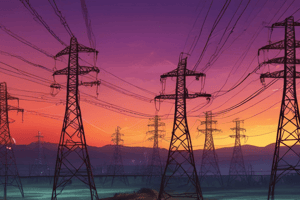Podcast
Questions and Answers
What is the primary function of a transmission substation?
What is the primary function of a transmission substation?
- To provide power to a single industrial facility
- To transfer power from the transmission system to the distribution system
- To operate at medium voltage levels
- To connect two or more transmission lines (correct)
What is the typical voltage range for a distribution substation?
What is the typical voltage range for a distribution substation?
- 2.4 kV-33 kV (correct)
- 110 kV and above
- 66 kV and 33 kV
- 765 kV and above
Which component is commonly found in a transmission substation?
Which component is commonly found in a transmission substation?
- Feeders
- Transformers for distribution
- Phase shifting transformers for distribution
- High-voltage switches (correct)
What is the primary purpose of a secondary power line?
What is the primary purpose of a secondary power line?
What type of substation is used to connect two or more transmission lines?
What type of substation is used to connect two or more transmission lines?
Which of the following is NOT a type of substation?
Which of the following is NOT a type of substation?
What is the primary function of a wave trap in a substation?
What is the primary function of a wave trap in a substation?
What is the typical voltage level for transmission-level voltages?
What is the typical voltage level for transmission-level voltages?
What is the primary function of a distribution substation?
What is the primary function of a distribution substation?
What is the purpose of a feeder in a distribution system?
What is the purpose of a feeder in a distribution system?
What is typically installed along long distribution circuits?
What is typically installed along long distribution circuits?
Which of the following is a component of a distribution substation?
Which of the following is a component of a distribution substation?
What type of substation is typically found in downtown areas of large cities?
What type of substation is typically found in downtown areas of large cities?
What is the purpose of a supply line in a distribution substation?
What is the purpose of a supply line in a distribution substation?
What is the benefit of having multiple supply lines to a distribution substation?
What is the benefit of having multiple supply lines to a distribution substation?
What is the typical location of underground cable lines?
What is the typical location of underground cable lines?
What is the primary function of a distribution substation?
What is the primary function of a distribution substation?
What is the typical voltage range of primary distribution lines?
What is the typical voltage range of primary distribution lines?
What component is used to measure electric voltage in a substation?
What component is used to measure electric voltage in a substation?
What is the main difference between urban and rural power line infrastructure?
What is the main difference between urban and rural power line infrastructure?
What is the purpose of a disconnect switch in a substation?
What is the purpose of a disconnect switch in a substation?
What is the main characteristic of distribution circuits?
What is the main characteristic of distribution circuits?
What type of transformer is used at the distribution substation?
What type of transformer is used at the distribution substation?
What is the purpose of a circuit breaker in a substation?
What is the purpose of a circuit breaker in a substation?
Flashcards are hidden until you start studying
Study Notes
Electric Power Distribution
- Electric power distribution delivers electricity from high-voltage transmission circuits to customers through medium-voltage primary distribution lines (600 V to 35 kV).
- A distribution substation steps down transmission-level voltage (35 to 230 kV) to several distribution primary circuits, which fan out from the substation.
- A distribution transformer takes the primary-distribution voltage and steps it down to a low-voltage secondary circuit (120/240 V) for end users.
Distribution Infrastructure
- The distribution infrastructure is extensive, delivering electricity to customers in cities, suburbs, and remote regions.
- Distribution circuits are found along most secondary roads and streets, with urban construction mainly underground and rural construction mainly overhead.
- Suburban structures are a mix of underground and overhead construction.
Substation Components
- A substation consists of primary power lines, secondary power lines, transformer, disconnect switch, circuit breaker, current transformer, lightning arrester, main transformer, control building, and security fence.
Types of Substations
- Transmission substation: connects two or more transmission lines, with high-voltage switches for fault clearance or maintenance.
- Distribution substation: transfers power from transmission to distribution system, operating at medium voltage levels (2.4 kV-33 kV).
- Collector substation: not specified.
- Converter substations: not specified.
- Switching station: not specified.
Distribution Substation
- Input voltage is typically at least two transmission or sub-transmission lines (e.g., 115 kV).
- Output is a number of feeders, which run along streets overhead (or underground) and power distribution transformers at or near customer premises.
- Distribution substations isolate faults in transmission or distribution systems and regulate voltage.
Feeder
- A feeder is a circuit conductor between the service equipment, source of a separately derived system, or other power supply source and the final branch-circuit overcurrent device.
Distribution Substation Components
- Supply line: connects to a sub-transmission system via at least one supply line, often called a primary feeder.
- Transformers: step down sub-transmission voltage to primary distribution voltage.
- Bus-bars: not specified.
- Switchgear: not specified.
- Out-coming feeders: not specified.
- Switching apparatus: not specified.
- Switches: not specified.
- Fuses: not specified.
- Circuit breakers: not specified.
- Surge voltage protection: not specified.
- Grounding: not specified.
Studying That Suits You
Use AI to generate personalized quizzes and flashcards to suit your learning preferences.




